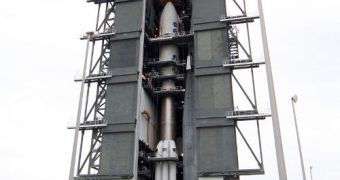Weather officials at the American space agency say that there is a 70 percent chance of good weather for the planned launch of the Juno spacecraft. The mission, which has been eight years in the making, is scheduled to blast off on Friday, August 5.
The probe will take off aboard an Atlas V delivery system, from the Cape Canaveral Air Force Station (CCAFS), in Florida. If all goes according to plan, it will reach Jupiter in about five years, and begin its scientific studies of the plane shortly thereafter.
Before this can happen, the satellite needs to cover more than 400 million miles. The last visit NASA made to the Jovian system was in 2007, when the Pluto-bound New Horizons mission flew past the gas giant. That probe will reach its destination in 2015.
In order to prepare for the upcoming launch, NASA engineers performed a dress rehearsal of the launch on Monday, August 1. Both the rocket and the spacecraft performed within optimal parameters.
Interestingly, Juno will be the first-ever solar-powered orbiter to travel to Jupiter. The $1.1 billion mission is destined to study the gas giant's chemical and physical composition, and to investigate its atmosphere, magnetosphere, gravitational field and so on.
“We're about to start our journey to Jupiter to unlock the secrets of the early solar system,” principal investigator Scott Bolton explains. The expert is based at the Southwest Research Institute (SwRI), in San Antonio, Texas, Space reports.
Once it enters orbit around the most massive planet in our solar system, Juno will perform around 33 orbits around Jupiter, giving its suite of 8 scientific instruments the chance to collect vast volumes of data on relevant parameters.
At its point of closest approach, the spacecraft will be flying a mere 3,100 miles (5,000 kilometers) above Jovian clouds, on a polar orbit. Completing the 33 orbits will take about a year, experts say.
One of the most important objectives is studying the dynamo effect powering up the planet's magnetosphere. Jupiter is known for having one of the most intense magnetic fields in the solar system.
“The Juno spacecraft will pass repeatedly just above Jupiter's surface, so we will get closer to the dynamo there than we could on any other planet in the solar system,” expert Jack Connerney says.
“That's a very exciting prospect because it will really enhance our ability to determine what's going on,” adds the scientist, who is the deputy principal investigator of the mission.
He is also the head of the magnetometer team at the NASA Goddard Space Flight Center (GSFC), in Greenbelt, Maryland. Juno carries two magnetometers, which will be used to create a high-definition view of the planet's magnetic field.

 14 DAY TRIAL //
14 DAY TRIAL //